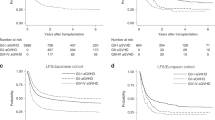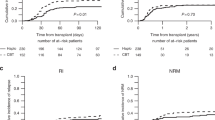Abstract
Large differences in patient and transplant backgrounds make it difficult to identify consistent prognostic factors of unrelated cord blood transplantation (UCBT) among different populations. Thus, we performed a collaborative study between Eurocord/ALWP-EBMT and JSHCT/JDCHCT. Adults with acute leukaemia who underwent a single UCBT were eligible. In total, 3764 and 1027 patients of the JSHCT/JDCHCT and Eurocord/ALWP-EBMT registries, respectively, were included. The median ages of the Japanese and European cohorts were 51 and 38 years, respectively. Three or more HLA mismatches were more frequently observed in the Japanese cohort. The median total nucleated cell (TNC) counts were 2.58 and 3.51 × 107/kg in the Japanese and European cohorts, respectively. Anti-thymocyte globulin was used in only 2% of the Japanese cohort compared with 65% of the European cohort. The 3-year overall survival (OS) was 41% in JSHCT/JDCHCT and 33% in Eurocord/ALWP-EBMT. In the multivariate analysis, TNC dose and HLA matching had no significant effect on OS in either cohort, whereas year of transplantation, age, and refined disease risk index affected OS in both cohorts. Despite considerable differences in characteristics between the Japanese and European cohorts, we observed similar prognostic factors affecting UCBT outcomes in adult patients with acute leukaemia in both registries.
This is a preview of subscription content, access via your institution
Access options
Subscribe to this journal
Receive 12 print issues and online access
$259.00 per year
only $21.58 per issue
Buy this article
- Purchase on Springer Link
- Instant access to full article PDF
Prices may be subject to local taxes which are calculated during checkout



Similar content being viewed by others
References
Rocha V. Umbilical cord blood cells from unrelated donor as an alternative source of hematopoietic stem cells for transplantation in children and adults. Semin Hematol. 2016;53:237–45.
Gratwohl A, Pasquini MC, Aljurf M, Atsuta Y, Baldomero H, Foeken L, et al. One million haemopoietic stem-cell transplants: a retrospective observational study. Lancet Haematol. 2015;2:e91–100.
Cohen YC, Scaradavou A, Stevens CE, Rubinstein P, Gluckman E, Rocha V, et al. Factors affecting mortality following myeloablative cord blood transplantation in adults: a pooled analysis of three international registries. Bone Marrow Transpl. 2011;46:70–6.
Ballen KK, Gluckman E, Broxmeyer HE. Umbilical cord blood transplantation: the first 25 years and beyond. Blood. 2013;122:491–8.
Atsuta Y, Kanda J, Takanashi M, Morishima Y, Taniguchi S, Takahashi S, et al. Different effects of HLA disparity on transplant outcomes after single-unit cord blood transplantation between pediatric and adult patients with leukemia. Haematologica. 2013;98:814–22.
Rocha V, Gluckman E. Eurocord-Netcord r, European B, Marrow Transplant g Improving outcomes of cord blood transplantation: HLA matching, cell dose and other graft- and transplantation-related factors. Br J Haematol. 2009;147:262–74.
Kai S, Wake A, Okada M, Kurata M, Atsuta Y, Ishikawa J, et al. Double-unit cord blood transplantation after myeloablative conditioning for patients with hematologic malignancies: a multicenter phase II study in Japan. Biol Blood Marrow Transpl. 2013;19:812–9.
Barker JN, Kurtzberg J, Ballen K, Boo M, Brunstein C, Cutler C, et al. Optimal practices in unrelated donor cord blood transplantation for hematologic malignancies. Biol Blood Marrow Transpl. 2017;23:882–96.
Hough R, Danby R, Russell N, Marks D, Veys P, Shaw B, et al. Recommendations for a standard UK approach to incorporating umbilical cord blood into clinical transplantation practice: an update on cord blood unit selection, donor selection algorithms and conditioning protocols. Br J Haematol. 2016;172:360–70.
Eapen M, Klein JP, Sanz GF, Spellman S, Ruggeri A, Anasetti C, et al. Effect of donor-recipient HLA matching at HLA A, B, C, and DRB1 on outcomes after umbilical-cord blood transplantation for leukaemia and myelodysplastic syndrome: a retrospective analysis. Lancet Oncol. 2011;12:1214–21.
Eapen M, Klein JP, Ruggeri A, Spellman S, Lee SJ, Anasetti C, et al. Impact of allele-level HLA matching on outcomes after myeloablative single unit umbilical cord blood transplantation for hematologic malignancy. Blood. 2014;123:133–40.
Barker JN, Scaradavou A, Stevens CE. Combined effect of total nucleated cell dose and HLA match on transplantation outcome in 1061 cord blood recipients with hematologic malignancies. Blood. 2010;115:1843–9.
Przepiorka D, Weisdorf D, Martin P, Klingemann HG, Beatty P, Hows J, et al. 1994 consensus conference on acute GVHD grading. Bone Marrow Transpl. 1995;15:825–8.
Sullivan KM, Agura E, Anasetti C, Appelbaum F, Badger C, Bearman S, et al. Chronic graft-versus-host disease and other late complications of bone marrow transplantation. Semin Hematol. 1991;28:250–9.
Giralt S, Ballen K, Rizzo D, Bacigalupo A, Horowitz M, Pasquini M, et al. Reduced-intensity conditioning regimen workshop: defining the dose spectrum. Report of a workshop convened by the center for international blood and marrow transplant research. Biol Blood Marrow Transpl. 2009;15:367–9.
Gooley TA, Leisenring W, Crowley J, Storer BE. Estimation of failure probabilities in the presence of competing risks: new representations of old estimators. Stat Med. 1999;18:695–706.
Fine JP, Gray RJ. A proportional hazards model for subdistribution of a competing risk. J Am Stat Assoc. 1999;94:456–509.
Armand P, Kim HT, Logan BR, Wang Z, Alyea EP, Kalaycio ME, et al. Validation and refinement of the Disease Risk Index for allogeneic stem cell transplantation. Blood. 2014;123:3664–71.
Shouval R, Ruggeri A, Labopin M, Mohty M, Sanz G, Michel G, et al. An integrative scoring system for survival prediction following umbilical cord blood transplantation in acute leukemia. Clin Cancer Res. 2017;23:6478–86.
Ballen KK, Logan BR, Laughlin MJ, He W, Ambruso DR, Armitage SE, et al. Effect of cord blood processing on transplantation outcomes after single myeloablative umbilical cord blood transplantation. Biol Blood Marrow Transpl. 2015;21:688–95.
Kanda Y. Investigation of the freely available easy-to-use software ‘EZR’ for medical statistics. Bone Marrow Transpl. 2013;48:452–8.
Wagner JE Jr., Eapen M, Carter S, Wang Y, Schultz KR, Wall DA, et al. One-unit versus two-unit cord-blood transplantation for hematologic cancers. N Engl J Med. 2014;371:1685–94.
Sanz J, Wagner JE, Sanz MA, DeFor T, Montesinos P, Bachanova V, et al. Myeloablative cord blood transplantation in adults with acute leukemia: comparison of two different transplant platforms. Biol Blood Marrow Transpl. 2013;19:1725–30.
Morishima Y, Morishita Y, Tanimoto M, Ohno R, Saito H, Horibe K, et al. Low incidence of acute graft-versus-host disease by the administration of methotrexate and cyclosporine in Japanese leukemia patients after bone marrow transplantation from human leukocyte antigen compatible siblings; possible role of genetic homogeneity. The Nagoya Bone Marrow Transplantation Group. Blood. 1989;74:2252–6.
Oh H, Loberiza FR Jr., Zhang MJ, Ringden O, Akiyama H, Asai T, et al. Comparison of graft-versus-host-disease and survival after HLA-identical sibling bone marrow transplantation in ethnic populations. Blood. 2005;105:1408–16.
Ikeda N, Kojima H, Nishikawa M, Hayashi K, Futagami T, Tsujino T, et al. Determination of HLA-A, -C, -B, -DRB1 allele and haplotype frequency in Japanese population based on family study. Tissue Antigens. 2015;85:252–9.
Kanda J, Brazauskas R, Hu ZH, Kuwatsuka Y, Nagafuji K, Kanamori H, et al. Graft-versus-host disease after HLA-matched sibling bone marrow or peripheral blood stem cell transplantation: comparison of North American Caucasian and Japanese populations. Biol Blood Marrow Transpl. 2016;22:744–51.
de Koning C, Admiraal R, Nierkens S, Boelens JJ. Immune reconstitution and outcomes after conditioning with anti-thymocyte-globulin in unrelated cord blood transplantation; the good, the bad, and the ugly. Stem Cell Invest. 2017;4:38.
Pascal L, Tucunduva L, Ruggeri A, Blaise D, Ceballos P, Chevallier P, et al. Impact of ATG-containing reduced-intensity conditioning after single- or double-unit allogeneic cord blood transplantation. Blood. 2015;126:1027–32.
Admiraal R, Lindemans CA, van Kesteren C, Bierings MB, Versluijs AB, Nierkens S, et al. Excellent T-cell reconstitution and survival depend on low ATG exposure after pediatric cord blood transplantation. Blood. 2016;128:2734–41.
Brunstein CG, Weisdorf DJ, DeFor T, Barker JN, Tolar J, van Burik JA, et al. Marked increased risk of Epstein-Barr virus-related complications with the addition of antithymocyte globulin to a nonmyeloablative conditioning prior to unrelated umbilical cord blood transplantation. Blood. 2006;108:2874–80.
Takahashi S, Iseki T, Ooi J, Tomonari A, Takasugi K, Shimohakamada Y, et al. Single-institute comparative analysis of unrelated bone marrow transplantation and cord blood transplantation for adult patients with hematologic malignancies. Blood. 2004;104:3813–20.
Acknowledgements
This work was supported in part by the Practical Research Project for Allergic Diseases and Immunology (Research Technology of Medical Transplantation) from the Japan Agency for Medical Research and Development, AMED (YA and JK) and JSPS KAKENHI Grant Number 18K08325 (JK).
Author information
Authors and Affiliations
Contributions
JK, HH, YA, and EG designed the research. JK, YA, and EG organized the project. JK, HH, and YA performed the statistical analysis; JK, HH, AR, FK, FV, ST, ML, SKako, SY, VR, SO, AN, YA, and EG interpreted the data; JK, HH, AR, FV, NU, SKato, HK, and YO gathered the data; JK wrote the first draft and all other authors critically reviewed the draft and approved the final version for publication.
Corresponding author
Ethics declarations
Conflict of interest
JK reports honoraria from Chugai Pharmaceutical Co., Ltd., Celgene K.K., Otsuka Pharmaceutical Co., Ltd., Janssen Pharmaceutical K.K., Takeda Pharmaceutical Company Limited., Astellas Pharma Inc., Bristol-Myers Squibb, Sumitomo Dainippon Pharma Co., Ltd., Ono Pharmaceutical Co., Ltd., JCR Pharmaceuticals Co., Ltd., Pfizer Japan Inc., Kyowa Kirin, and MSD Pharma, outside the submitted work. GS reports grants, honoraria, advisory role, and travel accommodations expenses from Celgene, advisory role from Abbvie, Helsinn Healthcare, Janssen, Roche, Amgen, Boehringer Ingelheim, and Novartis, and travel accommodations expenses from Takeda and Gilead Sciences, outside the submitted work. EF reports grants from Neovii, outside the submitted work. SKako reports honoraria from Chugai Pharmaceutical Co., Ltd., Celgene K.K., Otsuka Pharmaceutical Co., Ltd., Janssen Pharmaceutical K.K., Takeda Pharmaceutical Company Limited., Astellas Pharma Inc., Bristol-Myers Squibb, Sumitomo Dainippon Pharma Co., Ltd., Ono Pharmaceutical Co., Ltd., JCR Pharmaceuticals Co., Ltd., and Pfizer Japan Inc., outside the submitted work. JS reports and Advisory and Speaker’s Bureau for Novartis, Pfizer, Celgene, Daiichi-Sankyo and Jazz Pharmaceuticals. SY reports grants from Kyowa Kirin, Astellas Pharma, Chugai Pharma, Mochida Pharma, Lilly Pharma, Takeda Pharma, MSD Pharma, Pfizer, Dai Nippon Sumitomo Pharma, and Ono Pharma, outside the submitted work.YA reports honoraria from CHUGAI PHARMACEUTICAL CO., LTD., Kyowa Kirin Co., Ltd, Bristol-Myers Squibb Co., Ltd, Yakult Honsha Co., Ltd., Janssen Pharmaceutical K.K., Otsuka Pharmaceutical Co., Ltd, and Mochida Pharmaceutical Co., Ltd, outside the submitted work. Other authors declare that they have no conflict of interest.
Additional information
Publisher’s note: Springer Nature remains neutral with regard to jurisdictional claims in published maps and institutional affiliations.
Supplementary information
Rights and permissions
About this article
Cite this article
Kanda, J., Hayashi, H., Ruggeri, A. et al. Prognostic factors for adult single cord blood transplantation among European and Japanese populations: the Eurocord/ALWP-EBMT and JSHCT/JDCHCT collaborative study. Leukemia 34, 128–137 (2020). https://doi.org/10.1038/s41375-019-0534-5
Received:
Revised:
Accepted:
Published:
Issue Date:
DOI: https://doi.org/10.1038/s41375-019-0534-5



